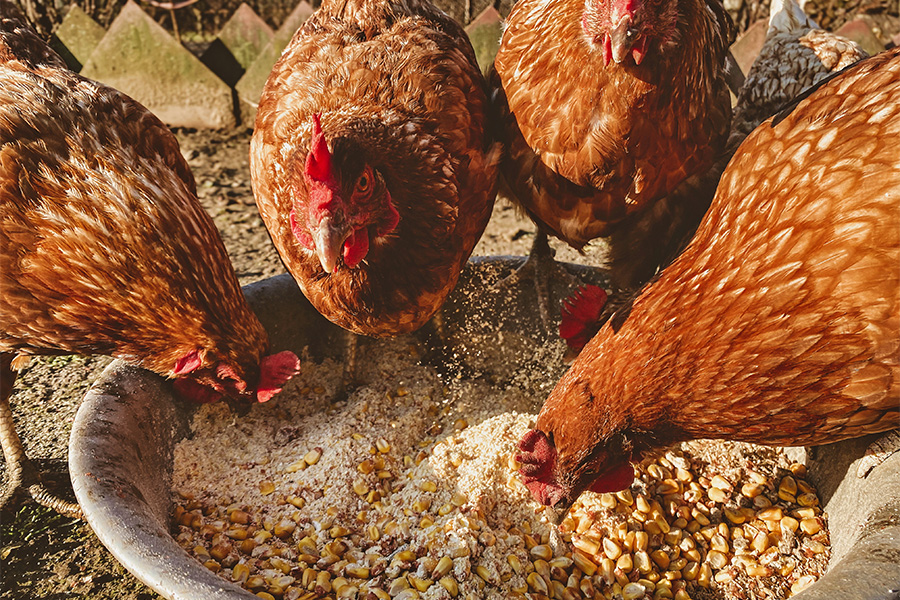Poultry
-

This bulletin is an educational reference for those who are interested in animal feeding and nutrition. It defines common terms used when discussing or reading about animal feeding and nutrition.
Uttam K. Saha and Lawton Stewart
|
-

The nutrients and organic materials found in poultry litter/manure are extremely beneficial by-products, as evidenced by the fact that years of application have transformed north Georgia from a severely depleted landscape in the 1920s and 1930s to a productive and green one today. Over-application or improper storage of poultry litter, however, can cause nutrient contamination of the state’s waters. Given the size and economic importance of this key agricultural industry, poultry producers must properly use this material to obtain maximum economic value of its fertilizer qualities while assuring protection of the environment.
Dan L. Cunningham and Casey W. Ritz
|
-

This Excel workbook will allow you to fit data from nutritional experiments to several models. It includes a PowerPoint presentation that shows you how to use the Excel workbook to fit several regression models to experimental data. The models may be used to estimate nutritional requirements or the most economical feeding levels of critical nutrients. All you need is Microsoft Excel (with macros enabled), the downloadable Excel file, and some input/output data.
Gene M. Pesti and Esendugue Greg Fonsah
|
-

This publication gives a procedure to calculate the value of broiler litter based on prevailing retail selling prices of commercial fertilizers containing nitrogen, phosphorus and potassium.
L. Mark Risse and Glendon H. Harris
|
-

Disposal of dead birds can be a problem for poultry growers. Typical methods of mortality disposal include burial, incineration, rendering, and composting. Many states have banned the use of burial pits that historically have been used to dispose of dead birds. Incineration can be costly and raise air quality concerns, and the decreasing number of renderers further complicates disposal. Composting is considered a positive alternative method of processing dead birds in an environmentally sound manner. This relatively inexpensive method of using dead birds has gained wide acceptance throughout the poultry industry.
John W. Worley and Casey W. Ritz
|
-

Poultry farming is the number one agricultural enterprise in Georgia. It is important to protect this vital industry by developing prudently-devised and factually-based zoning ordinances. This publication discusses components and terminology when drafting ordinances related to poultry production.
Dan L. Cunningham and Casey W. Ritz
|
-

In commercial poultry houses, bird density and distribution in drinking, feeding, and
resting zones are critical factors for evaluating flock productivity, bird health, and well-being. Proper distribution of chickens in the house greatly influences animal well-being and house environmental management. Currently, routine daily inspection of broiler flock distribution in commercial grow-out houses is done manually, which is labor-intensive and time-consuming. UGA poultry science researchers currently are developing an automated imaging system for monitoring floor distribution of chickens.Ongoing studies are focusing on detection of individual chickens with different gait scores in the research facility. It’s challenging to track individual birds with early health or welfare concerns using a computer vison-based method, but it is necessary and critical for producers to identify birds with well-being concerns and address those issues quickly.
Sammy E. Aggrey, Casey W. Ritz, Todd Applegate, Lilong Chai, and Adelumola Oladeinde
|
-

One of the most important components of a zoning ordinance for poultry farms relates to the set-back distance required for the location of poultry production houses. It is important that set-back requirements for poultry houses be based on facts rather than emotions.
Dan L. Cunningham and Casey W. Ritz
|
-

Georgia poultry farmers are among the best in the world at growing chickens using state of the art technology, housing systems, and best management practices. To protect this vital business for Georgia farmers, it is important that agricultural zoning ordinances be prudently devised and factually based.
Dan L. Cunningham and Casey W. Ritz
|